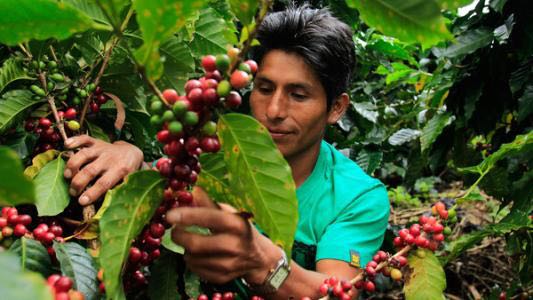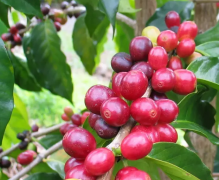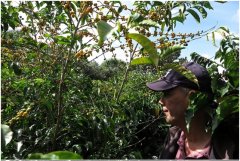The Tara Pearl producing area of Costa Rica introduces the reasons for the excellence of Costa Rican boutique coffee.
Costa Rica is located in the volcanic belt of the low latitudes of Central America, with the central plateau and mountains about 800 to 2000 meters above sea level.
The climate here has two obvious dry and wet seasons. The harvest period is from November to March of the following year, which coincides with the dry season, and coffee fruits of high quality and consistent maturity can be harvested. The dry season also provides sunshine conditions for the sun treatment, ensuring adequate precipitation in the rainy season. The fertile and well-drained pozzolanic soil provides sufficient nutrients for coffee growth, coupled with the growth advantage of high altitude, which has become a prerequisite for the breeding of high-quality coffee in Costa Rica.
Costa Rica's law only allows the planting of Arabica varieties, and Robusta is "contraband" in its territory, which shows the importance Costa Rica attaches to the quality of coffee. The varieties cultivated in Costa Rica are mainly caturra and catuai, and there are also many varieties in the country, the most famous of which is the bourbon variety villa sarchi, which grows very well at high elevations and has strong wind resistance. It can also grow in barren soil, and it will grow better under shade trees. The most remarkable feature is excellent sweetness and good acidity. Costa Rica's coffee skills are very high, regardless of breeding, planting or post-processing methods (especially honey treatment) can be used as a reference for various producing countries.
There are many excellent producing areas in Costa Rica, and the high-quality producing areas of Costa Rica have a common understanding of quality, that is, it requires the use of mature coffee fruits to ensure the production of high-quality coffee.
Generally speaking, a large amount of water is used in the post-processing of the picked coffee fruit, but the advanced production equipment in Costa Rica saves the use of water resources to the greatest extent, and a circulating filter is used to treat the waste water from washing coffee beans. let the waste water be purified into clean water to prevent pollution of the local soil environment.
After peeling, the peel and pulp of the coffee fruit are recovered as feed for livestock, or converted into organic fertilizer, as well as coffee bean dryer fuel. It can be said that in every process of coffee production, Costa Rica complies with the requirements of maintaining the natural environment.
Among the many excellent producing areas in Costa Rica, there is a famous producing area-Tarazu (Tarrazu), also known as Tarasu. Tarazhu is very famous in the world of boutique coffee and is one of the major coffee producing areas in the world. In the 2014 COE competition, of the 23 beans on the list, 17 came from Tarasu. Tarasu is located in the fertile volcanic region of Central America, which has a humid climate and fertile volcanic soil, abundant rainfall throughout the year, high altitude, and dense forest natural shade, providing a unique growth environment for coffee growth. Pesticides or artificial fertilizers are not used in the planting process. Nearly 95% of the coffee beans produced in Tarazhu Alpine are very hard beans (SHB), which generally grow above 1500 meters above sea level.
At present, the Tarazhu Cooperative has 26 member estates. Among them, Raminita Manor, which is one of the most famous coffee farms in Tarazu. La Minita produces about 1 million pounds of coffee beans a year, and after the entire estate produces coffee beans that are carefully selected to remove defects, only 15 per cent of the coffee beans can bear the mark of the Laminita estate, while the rest enter the coffee market. But the prices of these coffees entering the market are still higher than those of other beans produced in Central America. Raminita's strict management of all aspects of coffee production has established a world-class reputation and can be called a world-renowned coffee farm.
Costa Rica has a deep coffee culture, superb coffee skills, and produces world-class high-quality coffee. Costa Rica is an excellent coffee producer, both in terms of its innate environmental advantages and its acquired efforts to produce quality coffee. Although Costa Rica ranks third from the bottom in terms of land area in Central America, its economic environment is better than that of half of the countries. Colombians say that it is coffee that has changed the country and enabled people to enjoy a rich environment. Coffee has indeed made an outstanding contribution to this country, and it is the hard-working coffee people who have created excellent coffee.

Important Notice :
前街咖啡 FrontStreet Coffee has moved to new addredd:
FrontStreet Coffee Address: 315,Donghua East Road,GuangZhou
Tel:020 38364473
- Prev

Introduction to the flavor and taste of Chagg AA Coffee at Mosi Manor in Mount Kilimanjaro, Tanzania
Tanzania, which is adjacent to Kenya, produced coffee that was once famous for its extraordinary quality and unique taste, and was loved by coffee lovers. Later, under the influence of the national political situation, the coffee industry is declining day by day. In recent years, there is a warming trend, which still makes people look forward to it. Kilimanjaro is the highest mountain range in Africa, running through Tanzania
- Next

Honey-treated Fakaduai Fine Coffee Flavor and aroma description of the Manor of the Cocova Mountains in Panama
For professional baristas, please follow the coffee workshop (Wechat official account cafe_style). Do you remember the Panamanian Duncan geisha introduced not long ago? He is the masterpiece of the 2016 Best of Panama (Best Panama) award-winning manor and one of the star estates under Kotowa, Panama's famous and award-winning manor group. What I'm going to introduce today is her.
Related
- Does Rose Summer choose Blue, Green or Red? Detailed explanation of Rose Summer Coffee plots and Classification in Panamanian Jade Manor
- What is the difference between the origin, producing area, processing plant, cooperative and manor of coffee beans?
- How fine does the espresso powder fit? how to grind the espresso?
- Sca coffee roasting degree color card coffee roasting degree 8 roasting color values what do you mean?
- The practice of lattes: how to make lattes at home
- Introduction to Indonesian Fine Coffee beans-- Java Coffee producing area of Indonesian Arabica Coffee
- How much will the flavor of light and medium roasted rose summer be expressed? What baking level is rose summer suitable for?
- Introduction to the characteristics of washing, sun-drying or wet-planing coffee commonly used in Mantenin, Indonesia
- Price characteristics of Arabica Coffee Bean Starbucks introduction to Manning Coffee Bean Taste producing area Variety Manor
- What is the authentic Yega flavor? What are the flavor characteristics of the really excellent Yejasuffi coffee beans?

